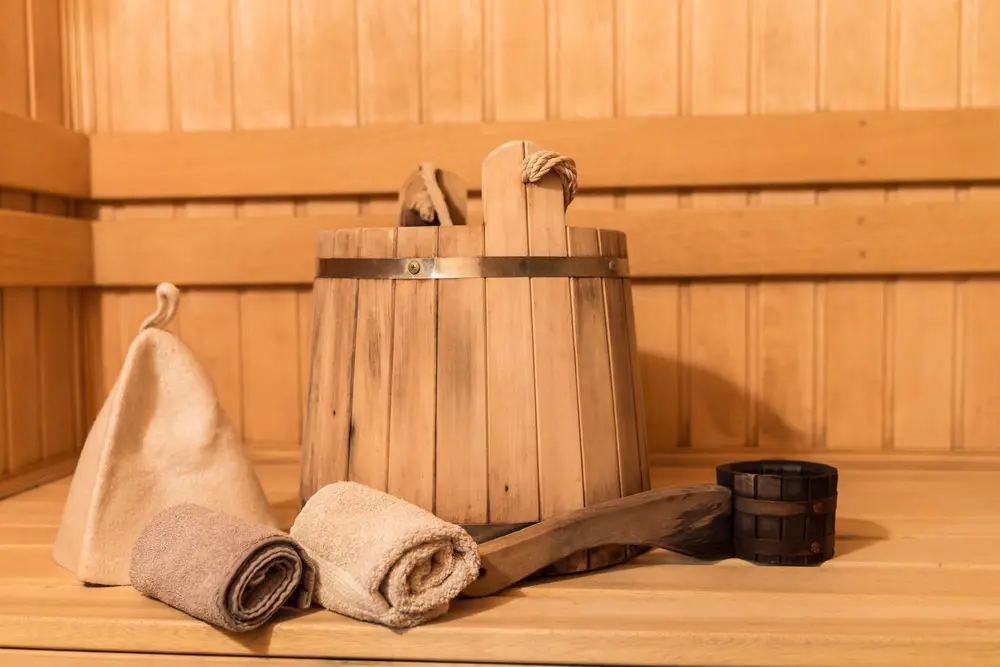The right design decisions can make the process of cleaning a sauna easier. It also ensures the installation remains efficient and sustainable in the long term
A certain connection to nature and self-care continue to be associated with saunas. And a sauna as part of a wellness area remains a key investment to attract customers focused on these values. However, many questions tend to arise around this installation, how to clean a sauna being a crucial one.
Cleaning measures in a sauna are not only important for hygienic reasons: they also ensure the installation lasts longer and requires less intensive and expensive maintenance operations. Let’s go through the key measures in how to clean a sauna for perfect customer experiences.
Dive deeper with the eBook
The sauna context: a traditional, yet in-demand wellness choice
Saunas remain one of the most popular wellness installations in spas, wellness centers, sport clubs, hotels, resorts and residential properties.
They provide a number of major health benefits, including those related to skin care, muscle relaxation, and detoxification. This is mainly due to the heat generated in the sauna, which has major positive influences on the human body, such as the release of toxins through sweating, the reactivation of blood circulation, and the improvement of breathing.
Understanding how to clean a sauna starts with looking at the materials employed to make them: wood represents the main component in sauna installations. In order to ensure proper insulation and add an attractive design, choosing the right type of wood for a sauna is a key aspect.
Depending on the humidity inside, a sauna can be wet or dry. The so-called wet sauna (where temperatures don’t exceed 70°C and the relative humidity is around 100%) is also known as a Turkish bath or steam bath. The dry sauna (with temperatures between 80º and 100°C and a humidity below 20%) is known as a Finnish sauna.
Apart from these traditional types of saunas, there are many others such as tropical baths, bio saunas, Russian saunas, salt saunas or infrared saunas — which at the same time can be indoors or outdoors.
No matter the type of sauna, there’s one thing all these installations have in common: it’s essential to know how to clean a sauna in order to guarantee a perfect wellness experience.

How to clean a sauna
Several factors can have an influence on how often to clean a sauna. However, if a sauna is used quite regularly, the recommendation is to clean it at least once a week.
While it might look like cleaning a sauna requires complex protocols or operations, it’s in fact as simple as following some specific steps that ensure total hygiene. When done the right way, these operations can also extend a sauna’s life cycle and keep it in ideal conditions for a perfect wellness experience.
Here are some of the key actions for cleaning a sauna:
Sweep and vacuum the superficial dirt
This is the first step when cleaning a sauna: sweep and vacuum the surface dirt to remove loose particles that can be found on the floor or attached to the wood. In order to do so, first use a hoover, and then sweep the remaining particles from hard-to-reach areas.
During this operation, make sure that neither the hoover nor the broom are made of materials that can damage the wood by scratching it.
Scrub and remove dirt or sweat stains
Once most of the dirt is removed, it is important to start cleaning the wood and the sauna areas.
Using a damp cloth or a sponge, drag and remove remaining dirt from the area. Soft detergent or natural products (such as bicarbonate paste or vinegar and warm water) are recommended. Spray the product evenly over the wood surface to ensure it remains wet for at least 3 minutes, and let the chosen product act. Then use a clean cloth to rub stains, rinse the surface and let it dry.
Grit sandpaper can be used for specially persistent stains. Afterwards, water rinsing is also recommended. Additionally, as a preventative measure, it’s recommended that users employ towels when sitting, thus avoiding sweat stains on sitting surfaces.
Disinfect ventilation areas and the rest of the installation
Operations concerning the cleaning of a sauna not only consist of cleaning seating areas: interior areas and accessories must also be taken care of. This includes burners, stones or electric heaters.
Again, it’s advisable to use natural products, such as lemon juice, for this operation: squeeze the juice and use a sponge to rub the desired surface. Then use water to rinse it and let it dry.
Consider scents and smell
While an important aspect is to use chemical products, these come with a key disadvantage: unpleasant, off-putting odors. In order to avoid them, incorporate a final step into the cleaning sauna routine and use pleasant perfumes to eliminate all kinds of unpleasant smells and generate a welcoming atmosphere.
Perform routine maintenance checks
After the sauna cleaning is finished, it is advisable to perform regular maintenance operations to check everything is in order and works properly. Burners, stones or electric heaters are crucial components of a sauna, in part because they’re also the main source of energy depletion. This is why it’s important to check and clean them periodically, in order to avoid dirt particles.

Wood maintenance: a key part in cleaning a sauna
As mentioned, most saunas are made of wood, because this material ensures the right insulation needed for a sauna environment.
Since exposure to high temperatures and moisture can affect its integrity and appeal, wood requires specific treatment and regular maintenance operations. On the one hand, temperature fluctuations may cause cracks on the wood while, on the other, steam may end up darkening some materials over time.
Some key considerations in how to clean a sauna’s wood surface include:
- In order to prolong this material’s life, it is essential to protect wooden sauna surfaces before using them by employing a breathable wood preservative product. This product can be based on oil or wax, and tinted options are available. Its main duty is to improve wood’s resistance to dirt and moisture, making it easier to clean. Moreover, it provides a more vivid tone to the wood.
- As mentioned, saunas must be regularly cleaned, and it’s important to note that disinfectants are not suited for wood cleaning because they can bleach the wood and cause irreversible damage to its surface. Pressure cleaning equipment should also be avoided, as pressure and excessive moisture may permanently damage the wood’s structure and surface.
- Special products for dirt-repellent protection can be applied longitudinally on the wood.
- Leave heaters on for at least half an hour while the air vent is open, and the door and windows closed. Let surfaces dry after cleaning the sauna by ensuring good ventilation.
- Advise users to not wear wet swimsuits in the sauna, as it will damage the bench. Seat covers are a good solution to protect this area.
- If possible, lift up the benches so they can dry more easily.
Main points on how to clean a sauna
High temperatures and humidity are the two core components in a sauna. At the same time, these are the two elements that can impair this installation’s running in the long term if proper cleaning measures are not ensured in order to eliminate all kinds of harmful microorganisms, fungi and bacteria.
Knowing how to clean a sauna can thus make a difference in the type of experience users have access to. It’s also an essential part of ensuring an extension in the sauna’s lifetime.
